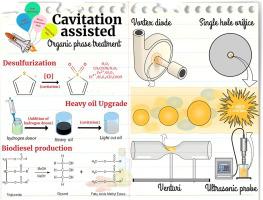Ultrasonics Sonochemistry ( IF 8.7 ) Pub Date : 2022-06-24 , DOI: 10.1016/j.ultsonch.2022.106081 Elvana Cako 1 , Zhaohui Wang 2 , Roberto Castro-Muñoz 3 , Manoj P Rayaroth 4 , Grzegorz Boczkaj 5

|
The present review emphasizes the role of hydrodynamic cavitation (HC) and acoustic cavitation in clean and green technologies for selected fuels (of hydrocarbon origins such as gasoline, naphtha, diesel, heavy oil, and crude oil) processing applications including biodiesel production. Herein, the role of cavitation reactors, their geometrical parameters, physicochemical properties of liquid media, liquid oxidants, catalyst loading, reactive oxygen species, and different types of emulsification and formation of radicals, formation as well as extraction of formed by-products are systematically reviewed. Among all types of HC reactors, vortex diode and single hole orifices revealed more than 95 % desulfurization yield and a 20 % viscosity reduction in heavy oil upgrading, while multi-hole orifice (100 holes) and slit Venturi allowed obtaining the best biodiesel production processes in terms of high (%) yield, low cost of treatment, and short processing time (5 min; 99 % biodiesel; 4.80 USD/m3). On the other hand, the acoustic cavitation devices are likely to be the most effective in biodiesel production based on ultrasonic bath (90 min; 95 %; 6.7 $/m3) and desulfurization treatment based on ultrasonic transducers (15 min; 98.3 % desulfurization; 10.8 $/m3). The implementation of HC-based processes reveals to be the most cost-effective method over acoustic cavitation-based devices. Finally, by reviewing the ongoing applications and development works, the limitations and challenges for further research are addressed emphasizing the cleaner production and guidelines for future scientists to assure obtaining comprehensive data useful for the research community.
中文翻译:

用于生物柴油生产和烃流加工的基于空化的清洁技术:对关键基础、缺失的工艺数据和经济可行性的看法——回顾
本综述强调流体动力空化 (HC) 和声空化在包括生物柴油生产在内的选定燃料(碳氢化合物来源,如汽油、石脑油、柴油、重油和原油)加工应用的清洁和绿色技术中的作用。在这里,空化反应器的作用,它们的几何参数,液体介质的物理化学性质,液体氧化剂,催化剂负载,活性氧,以及不同类型的乳化和自由基的形成,形成以及形成的副产物的提取审查。在所有类型的 HC 反应器中,涡流二极管和单孔孔板的脱硫率超过 95%,稠油改质过程中粘度降低 20%,3)。另一方面,声空化装置可能在基于超声波浴(90 分钟;95 %;6.7 $/m 3)的生物柴油生产和基于超声波换能器的脱硫处理(15 分钟;98.3 % 脱硫)中最有效; 10.8 美元/米3 )。与基于声空化的设备相比,基于 HC 的工艺的实施表明是最具成本效益的方法。最后,通过回顾正在进行的应用和开发工作,进一步研究的局限性和挑战得到解决,强调清洁生产和未来科学家的指导方针,以确保获得对研究界有用的综合数据。











































 京公网安备 11010802027423号
京公网安备 11010802027423号